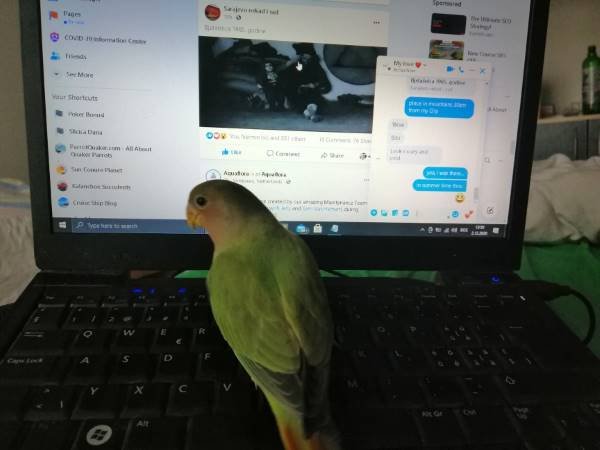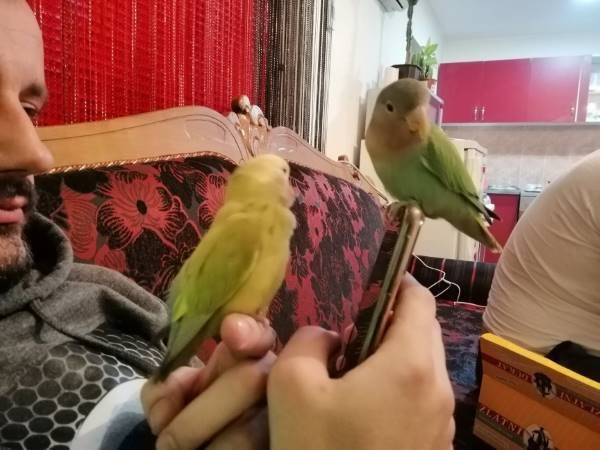Is it that time of the year when lovebirds are ready to breed? But how to be sure of the lovebird pair’s readiness to breed? And if they are ready at all, what should an owner do to safely and effectively breed his lovebird pair until the chicks are healthy and on-the-way to adulthood. Let’s know all the details about the breeding of lovebirds.
Know if the Lovebird is ready to Breed
- The prerequisite for lovebirds to breed is the attainment of sexual maturity. No lovebird less than the age of 10 months must be bred in any case. However, it is always best to wait until the birds turn a year old. Depending on the case-specific, some lovebirds might attain sexual maturity even later than this.
- Another condition that needs to be met before mating a pair is their bonding. If they do not feed each other and then preen each other, they will not mate until the feat is achieved. Once there, only then the pair is said to be ready to have bonded well to breed.
- The last and the most important part is where the lovebirds would convey to their owners that it’s time to breed. It happens when;
- Female lovebird would start shredding paper or other nesting material and tuck it under her wings/back and then carry it all to her nest box. This behavior is often seen in unbonded single females during the rainy season. If the female does not have a mate, then discourage this behavior immediately as the eggs would be empty.
- Males would regurgitate onto their human or lovebird mates as a sign of readiness. Again, this kind of behavior can be noticed in single, unbonded males. If the male does not have a mate, discourage this behavior by changing the diet of the bird and duration of the day-night to simulate summers.
Lovebird Breeding Fact Sheet
It is imperative to stay informed about all the facts of breeding a pet if one happens to own one. Thus, here are all the relevant facts of lovebird breeding:
Lovebird Breeding Season
Whatever part of the world one is in, the rainy season, i.e. the one around February/March is the ideal time to breed lovebirds.
Lovebird Breeding Age
The best breeding age of the lovebirds starts from 1 to 2 years. Only one clutch a year should be bred to keep the hen from getting malnutrition.
Lovebird Egg-laying & Incubation
The egg-laying starts anywhere from 3 to 10 days after the pair has mated. Eggs are laid every other day until 4 to 6 eggs are laid. The incubation takes around 22 to 25 days and the female incubates them solely. It must be noted that the chick might take as long as 24 hours to struggle out of the egg. It is best not to interfere as it might harm the sensitive offspring. The chicks then take 40-45 days to fledge.
Lovebird Breeding Guide
While in captivity, it is not just the lovebird that needs to get prepared for breeding and raising their family. The owner plays an equally important role in helping or sometimes, encouraging the pair to breed. Following are the little yet important preparations that must be undertaken by the lovebird’s human parents to help the little ones during breeding:
Nest Preparations
Add a small nest box at the darkest corner of the lovebird cage. Alternatively, many lovebirds love the hanging huts that give them a cozy, snug feel. But if the idea is to add a nest box, the ideal size of it is around 12 inches in length, breadth, and height with an entry hole of just 3 inches.

Line the floor of the nest box with non-toxic shavings of corn cob, sawdust, wood shavings, shredded newspaper, dried grass, et al. Add a layer of about 2 inches of it on the cage floor for insulation, absorb droppings of the chicks, and stabilize the eggs.
Breeding Environment
Creating an environment conducive to breeding is very imperative and might help a great deal. Provide a cage large enough so that the pair don’t end up fighting with the feelings of territoriality creeping between them.

The next step is to keep the bonded birds happy. Keep adding enough toys, perches, or the like activities to keep the environment fun and light. This will keep the lovebirds happy. And happy lovebirds mean better parents.
Breeding Diet
Just as humans, a breeding lovebird hen needs a special diet that supports the birth of healthy offspring. And such a ‘special breeding diet for lovebird’ starts way before the pair mates. This is meant to prepare the apt nutrient profile of the lovebird hen. And in some cases, the diet is planned in a way to encourage breeding/mating by titillating their hormones.
Diet to encourage breeding in Lovebirds
To make those hormones tickle in the bonded lovebird pair, feed the pair a special diet including:
- Lots of fresh leafy greens like spinach;
- Loads of fresh fruits like banana, apples, et al;
- Foods that are high in natural sugar like grapes since they add energy in the form of carbohydrates and makes the bird simulate breeding emotions;
- A lot of freshwater water; and
- Eliminate/reduce all the fattening and lethargy-inducing foods like seeds
Diet of an egg-laying Lovebird (hen after mating)
Once the pair has mated, chances are high that the hen might lay the eggs soon. Hence, it is important to feed her a diet that helps in keeping the mother and chicks healthy.
- Add a lot of calcium to her diet to help cover up the lost reserves while making egg-shells. One can also opt for high-quality calcium supplements to fasten the recovery. If one chooses supplement over the natural form of calcium, just serve it 5 times a week and not more than that;
- Add proteins in form of beans and legumes to help the hen supply enough amino acids to the chicks-in-formation; and
- Add a high-quality probiotic for lovebirds to maintain healthy digestion. The gut bacteria would help the hen absorb all the nutrients effectively and instantly, thereby, keeping both herself and the chicks healthy.
Read more About Lovebird Diet here.
Raising a Lovebird the Best Way
Lovebird hen would hardly let the chicks away from her sight, especially if she’s not bonded well with the owner. But if the chicks are allowed to stay with the parents all the time, they might not get tamed ever again. And removing them forever might make the parents feel depressed and they might attempt to kill their chicks immediately after they are born, in the next breeding round.

The best thing to do here is to walk the middle path; remove the chicks daily for a little time to bond/tame them and then put them back safely in the cage. Try not to take them out of the lovebird pairs’ sight in the beginning. This would help to gain the pair’s trust.
More about Lovebird Baby Care.
Lovebird Breeding Problems
If one has already sexed the lovebirds accurately, and then have made the pair bond well, the basic breeding problems can be assumed sorted. Now it is time for those breeding problems of lovebirds that might arise during the breeding process. Here is the list of the majority of them:
The biggest breeding problem these days is infertility. And it is not about infertile eggs owing to emptiness (lack of male lovebird). Infertility has become common among the bonded pair owing to poor diet, inappropriate age, faulty genetics, inbreeding, et al.
Another major breeding problem is the cost involved in making the pair breed. If one is doing it for a commercial motive, then it might not seem as lucrative as satisfying it could be. This has deterred many breeders to breed lovebirds haphazardly resulting in more failures than successes.
Summing Up
When in the wild, the lovebirds feel inclined towards breeding only when their body nutrient profile signals them to. They ‘just know’ when it is time to rear chicks that would survive healthily. But the responsibility shifts onto the owner when they are in captivity. Thus the human family must do everything they can, to make the breeding experience of the lovebird pair successful and smooth.



